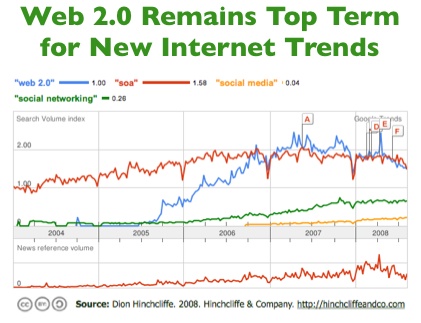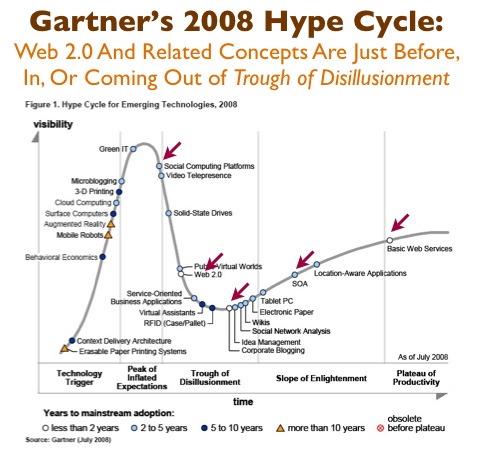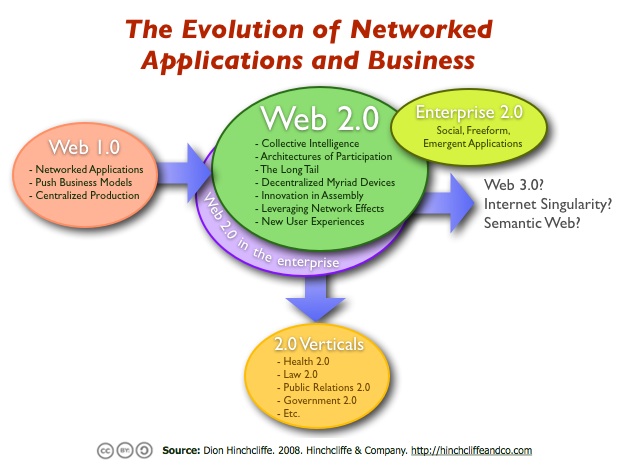While it’s no longer quite so fashionable to label your Internet startup a “Web 2.0” company these days, the popularity of the term remains extraordinarily high and is presently used today both far and wide in traditional media and social media. The Google Trends graph in the figure to the right tells the overall story; global search interest in Web 2.0 is more popular than “social media” and “social networking” combined and by a significant margin. About the only other strategic technology concept that has anywhere near the same volume of world-wide interest is service-oriented architecture (SOA), which as it turns out is also surprisingly closely related to Web 2.0. Granted, Google Trends is not a scientific, “bet-the-business” kind of source, but it’s a pretty darn good barometer.

Even for someone who spends much time with Web 2.0 concepts, I was surprised at this and I carried out a little cross checking from other sources and they all show the same disparity: Web 2.0 is still far and away one of the most popular terms to describe the intrinsic nature of many new online applications and businesses. This apparently highlights large scale demand for a broad enough term that rightly captures the innovations, new trends, and technologies that have emerged in the online space in the last few years. Web 2.0 has fit this bill better than any other single meme including the read/write Web, Social Computing, the Social Web, and the New Internet, to name just a few alternatives (and conceptually incomplete) terms that have been suggested.
The only real problem with this is that term itself has sometimes devolved into a vague buzzword that is often substituted as a simple synonym for social software or rich user experience techniques such as Ajax. Part of this is that the early investigation into Web 2.0 trends attempted to use it as a placeholder until the real underlying patterns were actually identified. This work resulted in the famous Web 2.0 meme-map that began to put meat on the bones and ultimately resulted in the excellent Web 2.0 Principles and Best Practices by my good friend John Musser. However, the lack of early specifics, though a brilliant move that allowed the right concepts to emerge from research into what was happening online, rather prescribing it blindly, also left a lasting impression of a vague, somewhat shapeless term for “newness” in the online world to the extent that even Tim Berners-Lee himself was left doubting.
However, it does appear that we are now left with both a very popular term that also has an increasingly large body of serious work that puts tremendous substance behind it. Academics such as Amy Shuen and her excellent Web 2.0: A Strategy Guide have produced enormous formal texts based on intensive research. A quick search of Google Scholar shows that over 14,000 references can be found. So too does the popular Web 2.0 Expo conference series continue and it has been expanding in recent years to the East Coast, Europe, and Asia. While the hype itself has largely dissipated and Gartner’s 2008 Hype Cycle report says it’s entering the trough of disillusionment, it also notes that “it will emerge within two years to have transformational impact, as companies steadily gain more experience and success with both the technologies and the cultural implications.” I could not agree more.

Web 2.0: The Concepts Spread to Other Fields
I’ve previously covered what Web 2.0 means exactly and the virtual ink spilled on this often surprisingly complex subject is itself vast. The Wikipedia definition of “Web 2.0” remains one of the most popular entries on the site and the number of offshoots of the term has been a saga in itself, from the early days of Advertising 2.0, Law 2.0, Library 2.0 to the newer, (generally) widely accepted terms Enterprise 2.0 and Government 2.0.
For simplicity’s sake, however, this is what we normally use to provide the most straightforward definitions of all things Web 2.0:
- Web 2.0 – The continuously changing, participatory Web with a focus on building collective intelligence on myriad devices and primarily servicing The Long Tail.
- Web 2.0 in the Enterprise – Web 2.0 as applied to business and not consumer activities.
- Enterprise 2.0 – The social, collaborative network with emergent behavior and structure.
At this point there are some that like to invoke Buzzword Bingo at such seemingly gratuitously coining of new terms, but I personally find this a crucially important point: The global network of the Web itself, which is shaped continually by the endless participation of hundreds of millions of users around the clock, is no more than a reflection of those that shape it (which are then shaped themselves by it.) That the principles of Web 2.0 cross all disciplines, types of business, types of government, languages, as well as types of people and culture has fostered an interesting phenomenon. Namely, each of these topical areas are in the various stages of translating how Web 2.0 transforms and improves what they do, from architectures of participation and harnessing collective intelligence to radical decentralization (with cloud computing being the most interesting new example) and open service ecosystems.

This “localization” of Web 2.0 into specific verticals appears to be a natural competitive response by those trying to incorporate the latest best practices and proven technique into their work. In fact, I find that non-technologists and those whose professions are not spent in the world of software or in Internet businesses have a hard time incorporating, indeed translating, the Web 2.0 body of knowledge to their line of work. So one by one, we can thank a largely self-appointed group of experts have taken the trouble to map the 2.0 works into the many aspects of the world that are steadily being remade by the increasingly pervasive presence of the Web.
And Web 2.0 isn’t standing still, we certainly haven’t figured out all the ways that we can leverage the network yet. As we start thinking beyond Web 2.0 we begin considering where sensor-gathered information of every description, location-awareness (the iPhone will drive this like few other devices today), and the glimmerings of semantic capability, we can see that eventually Web 2.0 will — like Web 1.0 — evolve into something else in its own right.
It took us almost 10 years to figure out how to begin to use the Web properly and it may take another 10 years from now before most of us are incorporating the lessons of web 2.0 deeply into how we run their businesses. The result will be a transformed business and competitive landscape with products and services created and delivered in ways very unlike today (see my Web 2.0 predictions for 2008 for some details on this). It’s also clear that the long-term implications will go well beyond that, similar to the way that the telephone, television, and especially the printing press changed how information was created, who could access it, and how it was owned and distributed. The parallels stop there since the deepest implications of 2.0 is a tremendous shift of control from the center of our networks to the edge.
What other 2.0 memes are you tracking? Please put in comments below.
